Zhu Qi
For the past ten years, Cang Xin’s art has always been questioning something, namely, what exactly is his art? He has done a series of performance art works, which have involved inviting people to stamp on plaster masks of his face, licking a multitude of different objects and people, changing clothes with many people of different identities, lying down in various different environments, and also his most recent works in which he depicts himself transformed into a part of various different things. It is hard to see any of this as Western-style modern art in the true sense of the term.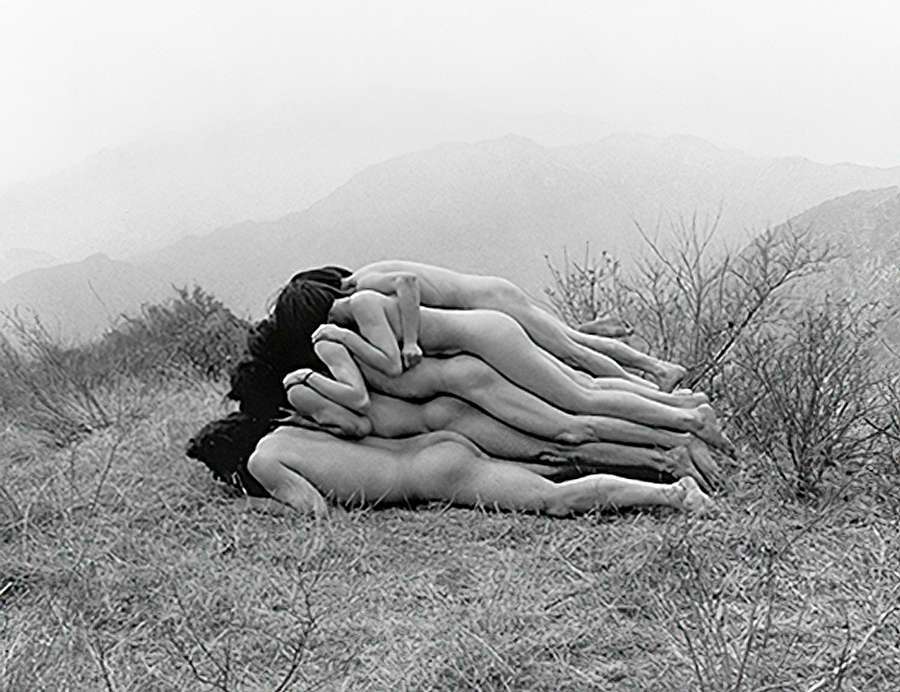
Apart from the famous group performance by East Village artists titled ‘To Add One Meter to an Unknown Mountain’, Cang Xin’s many works are on the whole difficult to assign to the Western-style categories of performance art or conceptual art. The Chinese idea of performance art is somewhat different to that of the West, partly because the term generally used in China is xingwei yishu, which translates literally as ‘action art’ or ‘behaviour art’, and Cang Xin has redefined the meaning of action art in his own way. His way is a shamanic vision of art located somewhere between sorcery, performance art and interaction; or to put it another way, Cang Xin’s art and identity move between the revelations of the shaman, the expression of the artist and the social experiments of the paranormal scientist.
For Cang Xin, it seems that art is not purely art, but the actions of a modern-day shaman that borrow the name of art. This gives his performance work a multi-layered quality, and blurs the boundaries of art itself. As an important representative of 1990s performance art in China, Cang Xin’s performance art definitely has a strong experimental quality concerned with the relationship between body and soul.
Trampling Faces: Conceptual Art’s Change of Direction
Performance art arrived in China in the late 1980s, but its real rise and first peak was around 1994 in Beijing’s East Village artist community. In 1995, Cang Xin, Ma Liuming, Zhang Huan and others realised the group performance ‘To Add One Meter to an Unknown Mountain’.
This work established that Chinese performance art had reached a mature stage, and was also a sign that conceptual art was changing and becoming nativised. The majority of artists in the early 1990s were inevitably influenced by European and American conceptual art, and as a member of the East Village art community, Cang Xin was no exception. This influence is reflected in his ‘Masks’ (Trampling Faces) series (1994).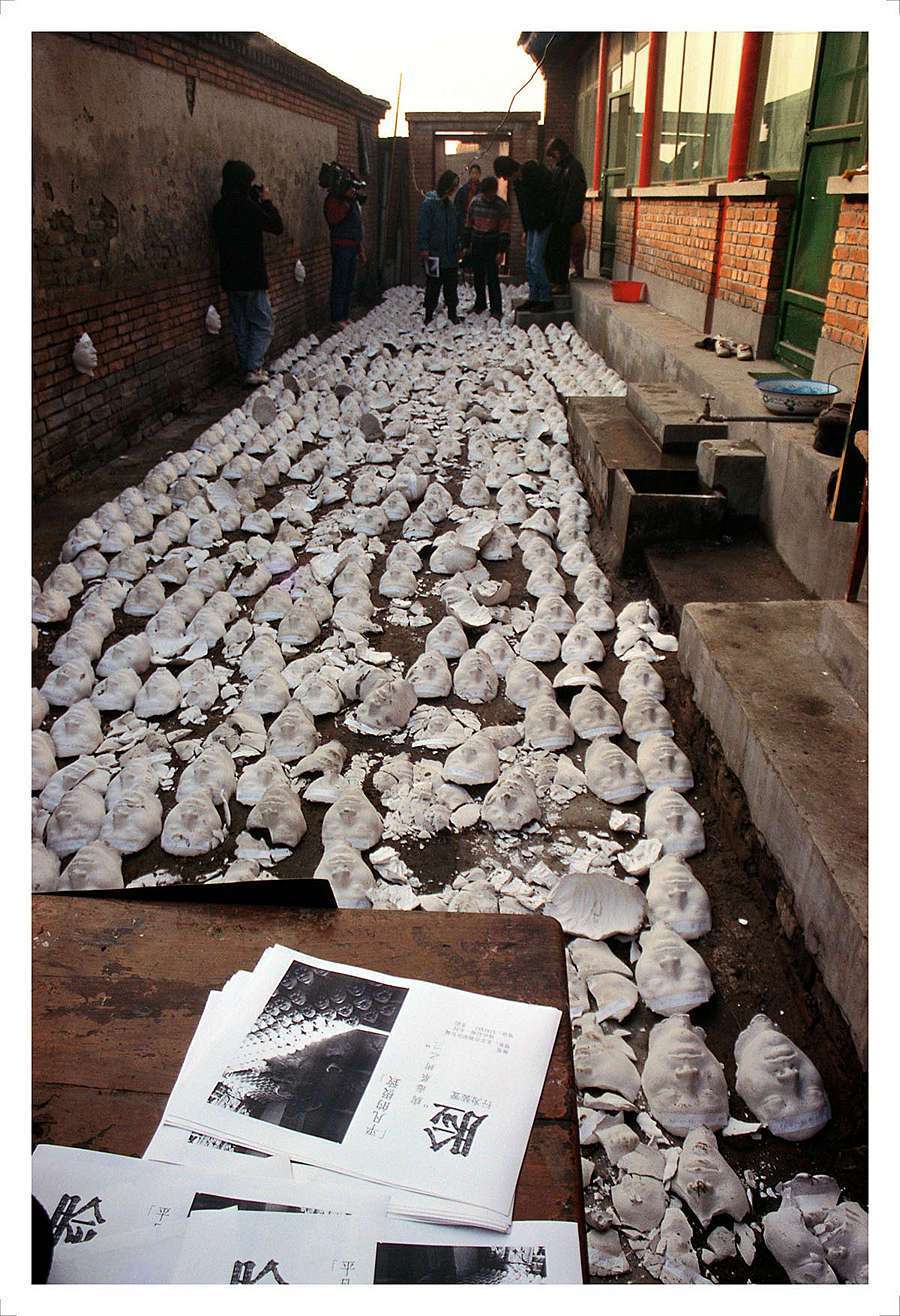
Conceptual art, which originated in the U.S. in the 1970s, is primarily an intellectual art movement that holds the concept of the art higher than any other aspect. As concept is also the root from which the form of an artwork grows, an artwork can still exist even if there is no visual form or medium, just the concept itself. In the early 1990s, Chinese avant-garde art became strongly conceptual, but artists tended to produce visual forms from their concepts. The conceptuality of conceptual art comes from a philosophical consideration of Western art theory, but the systemic roots of this kind of art could not be truly relevant for Chinese artists.
Consequently, the East Village artists did not actually make pure conceptual art, but neither did they move away from conceptuality. They emphasised forms that had a conceptual feeling, but in reality leaned more towards emphasising the live presence and experience of the body, and art actions as an individual response to local reality. This change of direction was probably instinctive for some of the East Village artists, because during live performances, the body often experiences things that transcend the concept and could not be anticipated in advance. At the same time, live performance art must have an element of spontaneity
In ‘Trampling Faces’, Cang Xin reproduced numerous identical plaster masks of his own face, laid them out on the floor and then let the audience walk on them, crushing them all to pieces. This performance combined various forms including site-specific installation, audience participation and conceptual art, the original concept being a symbolic criticism of the enforced uniformity of industrialised society and the mass reproduction of culture. Even though the form had been decided in advance, many non-conceptual parts of this work, such as the live experiential quality, the audience’s spontaneous reactions, and the unique spiritual sense of the work actually surpassed the concept when the work was realised. It is these non-conceptual parts that became the main orientation of Cang Xin’s later performance work.
In the ‘Masks’ series, the symbolism of the masks was originally the core concept of this work, but in practice what made this work interesting was not the concept of the masks, but the action of trampling them. The action of trampling not only emphasised a sense of physical contact in performance art, but there was also a spiritual quality about the feet coming into contact with the masks. This live, symbolic form of communication had something mystical about it, a collision of souls brought about through the medium of the masks, and this is an essential quality of Oriental art.
Cang Xin’s East Village period was in fact similar to the other artists in the community. Because of the influence of conceptual art, their works prior to realisation emphasised a holistic form established by conceptual thinking, but at the stage of realisation, all inevitably turned towards the methods of audience participation and spontaneous reactions. By the late 1990s, however, he was no longer just conceiving corresponding forms according to concepts, but had started to look more consciously for an Oriental quality in his concepts, and was paying more attention to creating improvised experiences in his live performance. Through physical contact, interaction with participants and concepts informed by shamanism, he arrived at a kind of individual vision of experienced reality.
The masks cast from Cang Xin’s own face lay in a neat and orderly arrangement under the audience’s feet, and induced a feeling of nervous tension in the people who walked over them. This kind of interactive ritual became the basic method of Cang Xin’s later performance art works, a method that emphasises bodily experience and breaking through the boundaries of communication with others.
Licking: Making Contact with Kindred Souls
Cang Xin’s sensitivity to the tip of the tongue seems to be part of his nature. This could be because of his Manchurian background and exposure to the shamanist religious practices of northeast China. Cang Xin began using his tongue to lick various objects as early as 1996, and since then has licked a myriad objects, a virtual encyclopaedia of the things that exist in his world.
He has licked books, cups, carved seals, exhibition catalogues, paper money, cameras, light bulbs, bricks, shoes, even portraits of Sartre and Nietzsche, not to mention the Great Wall, the Forbidden City and the ground in Oslo, Norway. During a performance in Oslo, he also interacted on-site with a Norwegian woman by touching tongues with her. Cang Xin refers to these actions as ‘contacts’ or ‘communications’.
The act of licking has a strong sense of ritualised action, which can be seen as coming from the formal influence of conceptual art. Later, Cang Xin paid less and less attention to forms created from concepts, and the forms of his work became more like altered personal rituals related to shamanism. Within his personal appropriation of modern artistic ceremony, Cang Xin emphasises Oriental concepts such as ‘all the ten thousand things have souls’, as well as the vehicle of ‘licking’, an action with a strong physical and tactile quality. He has abandoned the Platonic ideals that form the philosophical base of Western conceptual art, and is searching for the conceptual basis of a performance art that takes pushing the limits of bodily experience as its basic artistic method. 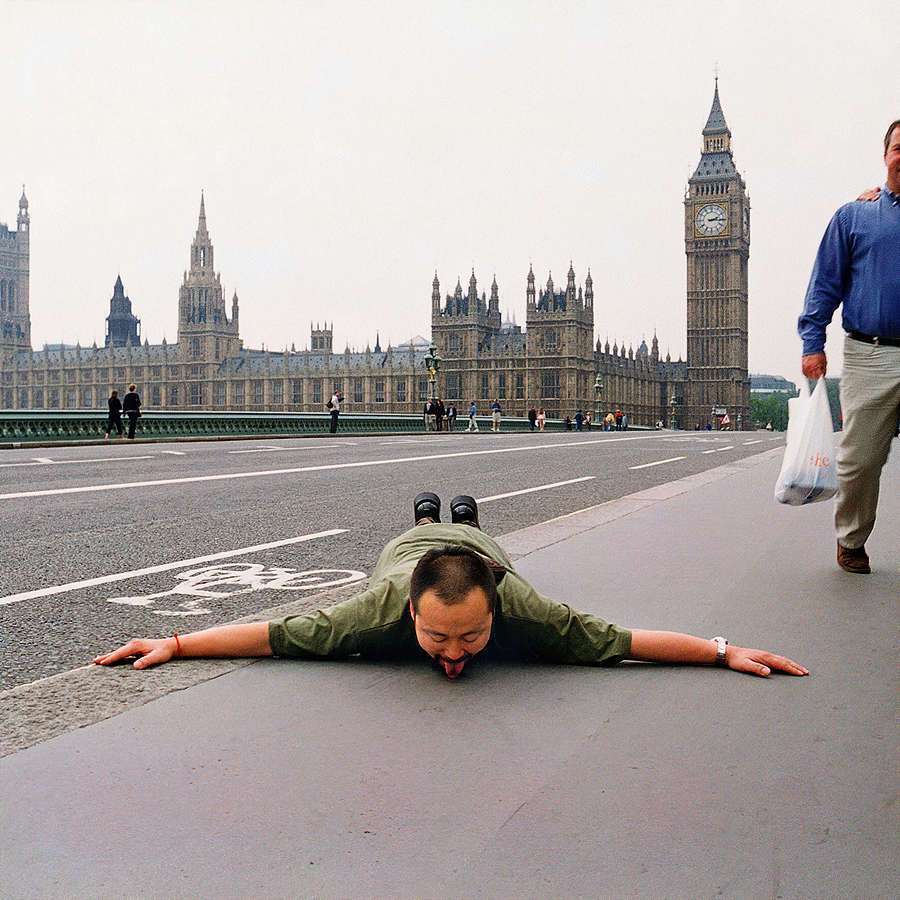
The ‘Licking’ series was also where Cang Xin officially began to engage and experiment with the mystic spirituality of shamanist culture, and the idea of spiritual communication between the ‘ten thousand things’. His closeness to shamanism in fact originates from his unconscious search for his Manchurian roots, and it seems that during the gradually realised process of the ‘Licking’ series, the desire to return to the roots of his individual self grew in his heart. Although Cang Xin’s ‘Licking’ series still presents itself as modern art, it has in fact already started to become more of a rational mysticism, and the works seem more and more like a re-visitation, through art, of Oriental concepts of the soul.
In ancient China and across the Far East, the so-called ‘myriad objects’ or ‘ten thousand things’ were vessels that contained life. A tree or a chair was a living object with a spirit, and in a previous existence a person or even a pig may have been the vessel that embodied that same spirit. This idea occurred to Cang Xin one day when he was still a child. He was at the market buying fish with his mother, a devout Buddhist. There in the market, his mother related to him the traditional practice of lowering a banner on a certain day of the year to release the spirits of the ‘ten thousand things’ from their vessels. Like a revelation of sorts, he came to the realisation that ‘I could be them (the fish) and they (the fish) could be me’, and he has been intrigued by this concept ever since.
It was during the nineteenth century, as Western scientific thought was gradually introduced to China, that the underlying notion of the object existing apart from the spirit began to occupy a central and guiding place in modern Chinese thought. No doubt the scientific and pragmatic ideas of industrial culture exerted a similar influence on art. Thus, even in on-site performances and happenings, artists tended to emphasise concept over form in their approach. This intellectual approach meant that spiritual communion and emotional expression were often relegated to a position of secondary importance.
Through his many performances involving ‘communication’, Cang Xin tries, in a manner reminiscent of primitive religious practices, to achieve a devotional contact with the myriad objects around him. In doing so he becomes a conduit for spiritual communion, and through the experience of communicating with the spirits embodied by various objects around him he achieves a certain relativism as it might exist in the various types of objects and the various cultural systems with which he comes into contact. Cang Xin’s performance art in this series is in fact preparing to break through the boundaries of art, and this is evident in the way that his performances both look like art and also like the mysterious rituals of a young shamanic sorcerer. After seeing documentary photographs of these performances that seem to be what they are not, and have no fixed artistic definition, Cang Xin gradually realised that his art and identity were in the process of making an exciting but risky transgression. Essentially, this transgression was not following the direction of Western art but returning his ancient roots.
What Cang Xin found more and more interesting were the multi-layered roles he perceived in his own identity when in the process of licking things. He was an artist, but at the same time also a high priest and an experimental scientist. In the Middle Ages, priests or shamans were synonymous with scientists and only later were they gradually separated into two distinct roles, which eventually evolved into the two distinct systems of thought and spirituality. Thus developed the split between the mind and the heart commonly found in modernism. In traditional China, the words xinling (heart or soul) and sixiang (thought) were often combined in the word xinsi (heart thoughts). The heart and the mind were one and the same, inseparable. The spiritual way of the sorcerer has many similarities to that of the modern artist.
Cang Xin’s ‘communicative’ lickings use the tongue to ‘converse’ with all kinds of living and non-living things. Making contact with organic and inorganic substances in this way is like contact between two souls, or like two souls whispering quietly to each other. This spiritual relationship grows naturally between two life forms; they permeate each other and suddenly form a sort of direct spiritual attraction.
With this interactive method based on shamanic magic, Cang Xin is actually bringing biological myths into his art practice. The spiritual games he plays with shamanism, in the name of contemporary art, are also bringing the two roles of scientist and priest closer together and fusing them on a spiritual level, thus material objects are no longer materialised but spiritualised.
This method has provided Cang Xin’s art experiments with a context to occur in that holds individual clues, and in fact has also enabled Cang Xin to find a unique personal starting point for his conceptual thinking.
Identity Exchange: Entering the Bodies of Others
The ‘Licking’ series was based on psychological interaction, and Cang Xin gradually limited the objects he licked to those which had a particular kind of identity or symbolic quality. His method involved direct use of the sensory organs, but the things he licked were symbolic or emblematic objects, or else they were licked in front of extremely symbolic buildings and gained significance because of what was in the background. This also applies to his sensory communications with people of different gender, identity and cultural background, that took place in various locations around the world.
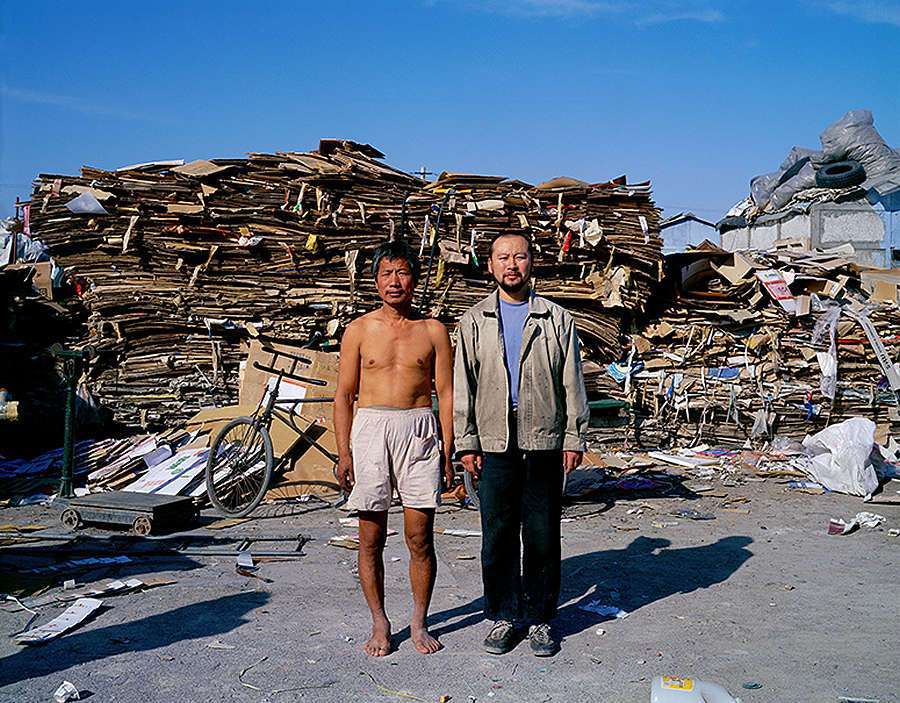
This series also held clues that suggested how the later ‘Identity Exchange’ series would develop. Cang Xin’s ‘Identity Exchange’ series is a kind of performance photography, that appears to be an ironic portrayal of social reality and a depiction of the fate of humanity in a period of social transition. However, the essential nature of this series lies in utilising the forms of social identity and status to conduct an ongoing experiment in soul communication. From ‘Trampling Faces’ to the ‘Licking’ series, ever since his artistic experimentation began back in the East Village community, Cang Xin has always shown an unconsciously individual direction, namely that he is more concerned with the inner spiritual communication of performance art and with seeking out the origins of the self.
In this series Cang Xin exchanges clothes with many people of different identity and social status, including a chef, a university lecturer, a police officer, a mental patient, a Peking opera performer, a waitress, a rubbish collector, a doctor, a rock singer, a salesman, a farmer and many others. The photographs are taken in environments that indicate the identity of the collaborator with Cang Xin wearing the clothes that symbolise their professions. Cang Xin conveys a sorrowful sense of predestination, not without black humour. But on another level, these pictures seem to present, one after another, a stream of individual souls who are disturbed, uneasy, and trapped in a state of constant change.
Through the symbolic exchange of identities through clothes, Cang Xin seems to have entered into the bodies of others through a symbolic act, a modern approach to the traditional concept of souls travelling between bodies. Using this approach, Cang Xin also seems able to reveal the modern fate of the soul, namely that souls in contemporary society no longer seem to be connected to nature and possess universal meaning, In modern society, the soul as well as the body is uniformed and defined by profession. Freely travelling in and out of different bodies is in fact the traditional spiritual realm of the shaman, and through this going in and out of various other bodies, souls achieve freedom and can communicate with each other. But in Cang Xin’s ‘Identity Exchange’ series, it is as if this sense of freedom is endowed with a sad modern mood; he is like an ancient sorcerer observing the fate of wounded and uncertain souls in modern society.
In this series Cang Xin also found, through the medium of the identified body, an inherent social form in the concept, something more meaningful than an abstract form based on pure concept. The ‘Identity Exchange’ series sets up conditions where the self or soul can enter a social context. He has found a more internal mode of entry, but this series seems to be presented more as an experience of dressing up in a symbolic but borrowed outer clothing, a way to verify the probable differences between souls in modern society and their common nature. Also, Cang Xin is merely sympathetic to the plight of the other soul, and has by no means rescued the possibilities of that soul.
A paradox exists within, namely that he has the power to enter the body of that soul but is unable to take on that soul’s suffering or release it. This perhaps reflects the subjectivity of the artist, but as to how the shaman treats suffering and rescues souls, Cang Xin’s work does not make his attitude clear. Cang Xin presents himself more like a modern sorcerer who appears in the guise of an artist and is still in a state of travelling, experiencing and observing. He has still not considered clearly the fate and salvation of modern souls, and is still just going in and out of different bodies.
This approach is also reflected in Cang Xin’s ‘Heaven and Man as One’ series, and the ‘Red’ series. ‘Heaven and Man as One’ shows Cang Xin lying like an exhausted and peacefully sleeping child in different natural and urban situations, including a construction site, grassland, a pond, the Western desert and so on. The ‘Red’ series shows Cang Xin together with people of different races, as if the souls of different races were finding a way of interacting with each other.

Shamanic Visions: Becoming a Part of Them
Cang Xin‘s recent works are transcendent, imaginative images inspired by shamanism. He envisions himself hanging from the branches of a tree like fruit, or as the stamens of water lilies covering a pond; he imagines himself sleeping curled in a foetal position inside a block of ice, or that a giant crocodile has already swallowed the lower half of his body while he remains absorbed in his writing. He imagines that his head is separated from his body, that he is encircled by a tribe of natives engaged in a magic ritual, or that his head is buried in the earth and tree branches are sprouting from his back.
The spiritual influence of shamanism was already present in much of Cang Xin’s earlier work, such as the ‘Masks’ and ‘Licking’ series, and especially in ‘Communication’, a series of performances in which he used his tongue to verify that an individual human being can interact with all things on earth. In recent years, Cang Xin has more consciously used art to explore the culture of shamanism, the experimental images of the ‘Shaman’ series being an example of this.
Mystical forms of communication have been a spiritual theme of Cang Xin’s work since the mid 1990s. He has, for example, trampled ‘masks’ of his own face underfoot, and used his tongue to lick a vast array of objects and substances, both external, physical types of contact that express an internal, mystical quality. The ‘Identity Exchange’ series (2000) also expressed the idea that two individuals of differing identity, standing side by side and stripped of their identifying clothing, would in some way enter into each other, showing that the primeval mystery of people switching roles with each other still exists in modern society.
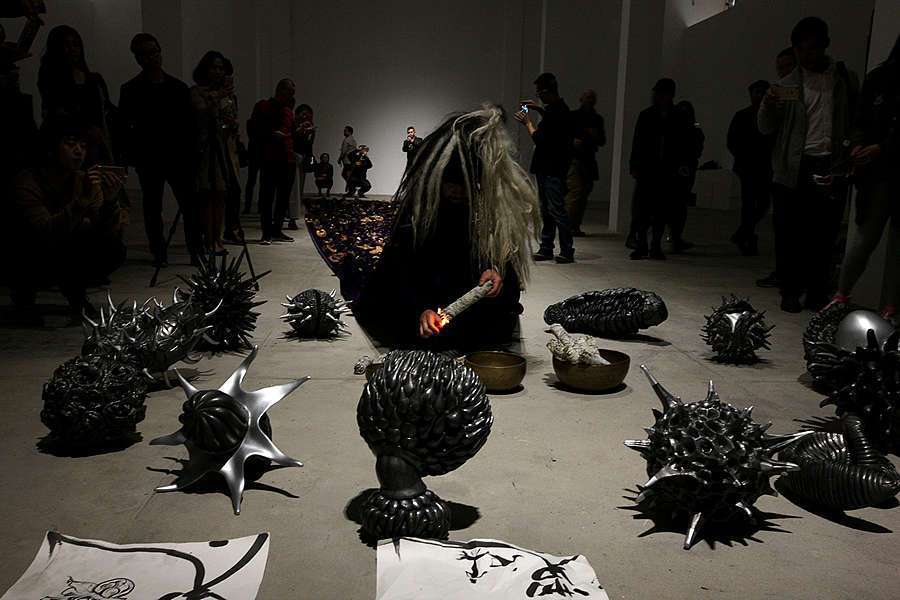
If we say that performance art is limited to contact on a physical and material level, this would seem to be a level distant from the shamanic imagination. Shamanism is an animist religion that can be traced back to the ancient Nuchen people, ancestors of the Manchus. Shamanists believe that everything in the world has a soul, and that there is no real divide between the various creatures and things that inhabit the world. Humans are not separate from animals, gods, plants, or even heaven and the underworld. In shamanist mythology, their ancestors were a tribe of animals who possessed the ‘three souls’ of life, thought and reincarnation. These souls could pass between different worlds, beings and things in the process of reincarnation.
Cang Xin’s ‘Shaman’ series employs the method of drawing to create pictures in which he appears to be doing performance art. In these imagined performances, Cang Xin goes beyond the physical and material limitations of performance art and enters into visions that transcend experience. This not only lets his imagination work with a powerful and unrestrained style, it also brings him closer to the transcendent spirit of shamanism.
Performance art by its very nature has a sense of presence and reality, but in fact Cang Xin’s mid 90s performances in the East Village already showed a different spiritual orientation to those of Ma Liuming, Zhang Huan and the other artists of that community. In performances such as the ‘Masks’ series, he tended more towards an occult, shaman-like quality of action. In the later ‘Licking’ series this evolved into a mature approach concerned with spiritual interactions of a mystic or shamanic nature. From 2000 on, the subject matter of the ‘Identity Exchange’ series leant more towards realism, dealing with changes and displacement of social identity. Since completing that series, Cang Xin has been trying to transcend the limitations of performance art since the 1990s.
With the ‘Shaman’ series, Cang Xin has found a way to transcend those limitations of presence and reality. In these images he can be even more like a sorcerer, transforming himself into many different incarnations – animals, plants, and hybrid monsters that are half-man half-animal, or half-man half-plant. He can also carry out a range of mystical shamanic actions and experiences, such as burying his head in the earth, sitting cross-legged in the air, swallowing huge insects, lying amid a pile of corpses, walking on the leaves of a tree, hibernating in an icy crevice and so on.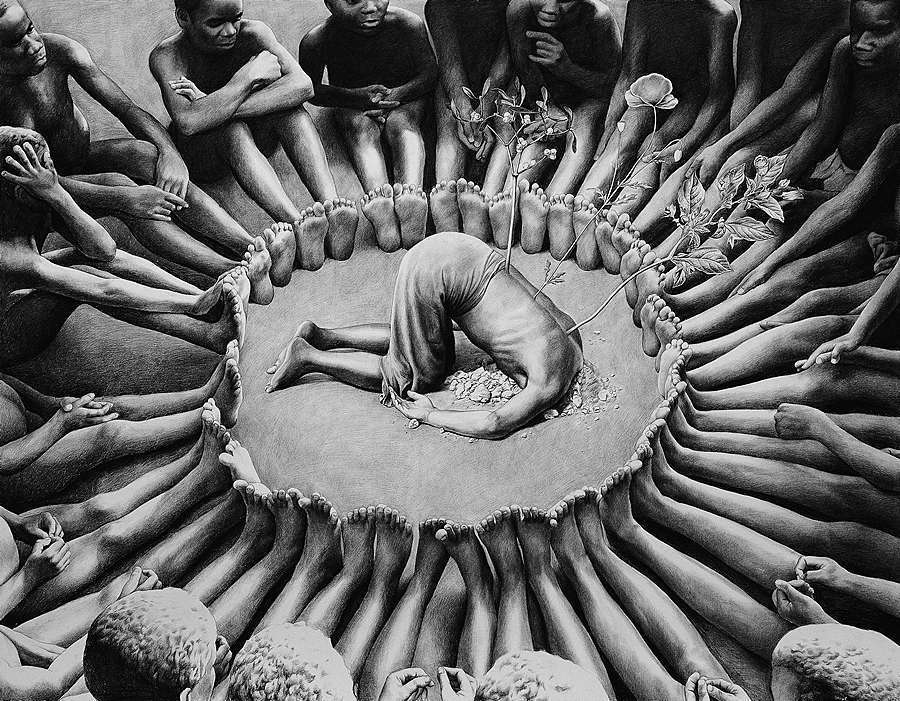
One of the clear artistic themes of Cang Xin’s ‘Shaman’ series seems to be a return to the primeval spirit of art and the mystical essence of human nature. Or, rather than call it a ‘clear artistic theme’, perhaps it is more accurate to say that in this series Cang Xin has clearly defined what he wants to convey with his art. As someone of Manchurian descent, a return to the religious spirituality of the East, and more specifically to the mystical spirituality of shamanism, has always been an underlying desire in Cang Xin’s art. This desire finds expression not only in his attempt to rediscover the native origins of art, but also in his attempt to pursue, through shamanism, a sort of mystical dialogue with the roots of individual and self. This concept seems to be expressed increasingly clearly in the ‘Shaman’ series.
These ‘shamanic visions’ make Cang Xin seem less like a contemporary artist and more like a sorcerer who appears in modern society wearing the guise of an artist. In shamanist culture, the shaman is an important figure who is able to communicate with souls in the three realms – the realm of heaven, the realm of man and the realm of earth. Only the shaman can communicate with souls across these three realms. Cang Xin has previously played a similar role in the ‘Licking’ series, by using his tongue to communicate with the internal spirit of each kind of object or substance, and in the ‘Identity Exchange’ series, in which a mysterious connection was established between Cang Xin and the people whose identities he entered by changing clothes with them. However, in those performances, Cang Xin was acting more as a messenger between different objects or members of society, and did not become a part of them.

Shamans are seen as mysterious spiritual envoys who can traverse the boundaries of life and death, going in and out of different bodies; this is also the shamanic ideal of free movement of the soul. Cang Xin’s ‘Shaman’ series goes beyond the identity of ‘artist’ to ask the following questions: What kind of person is an artist, after all? In a spiritual sense, are they modern-day shamans? Of course, Cang Xin does not define himself in this way, but in his imaginative experimentation with ‘shamanic’ images, he more or less presents himself as a shaman of the imagination, who can freely experience different forms of life and death, penetrate different geographic spaces, enter and exit all kinds of different bodies and become one with them. With this kind of going in, out or beyond, he is no longer just a messenger between souls, but is travelling deep into the bodies in which these souls exist, making direct contact with them, and experiencing what sort of souls they are.
He wants to become them, be they people or animals or inanimate objects; this is the motive of Cang Xin’s ‘Shaman’ series. There has always been a mysterious sense of ritual in his performance art works, and in this series he is attempting to transcend the nature of contemporary art itself. Through the transcendent actions of art, he is searching for the restlessly wandering nature of the soul, something that modern art has also been searching for but has not yet found, namely, the modern plight of our souls, and how our souls are affected on their journey by the grotesque and gaudy strangeness, the terror and beauty of the modern world.
You could say that Cang Xin’s performance art has walked a road unique to itself. The core of this road lies in searching for the conceptual foundation of performance art and the individual roots of physical experience in his native society. He draws on the roles of shaman and modern scientist, and the possibility of direct soul communication with others. He has gradually broken away from the modes of Western conceptual art, and searched more consciously in the inner depths of his soul for the ideological or philosophical origins of action. By constantly forcing his body past its perceived boundaries, he has repeatedly challenged, with his own experiences, existing concepts about art and the identity of the artist.
Zhu Qi,
August 6th 2005 written in Wangjing, Beijing.